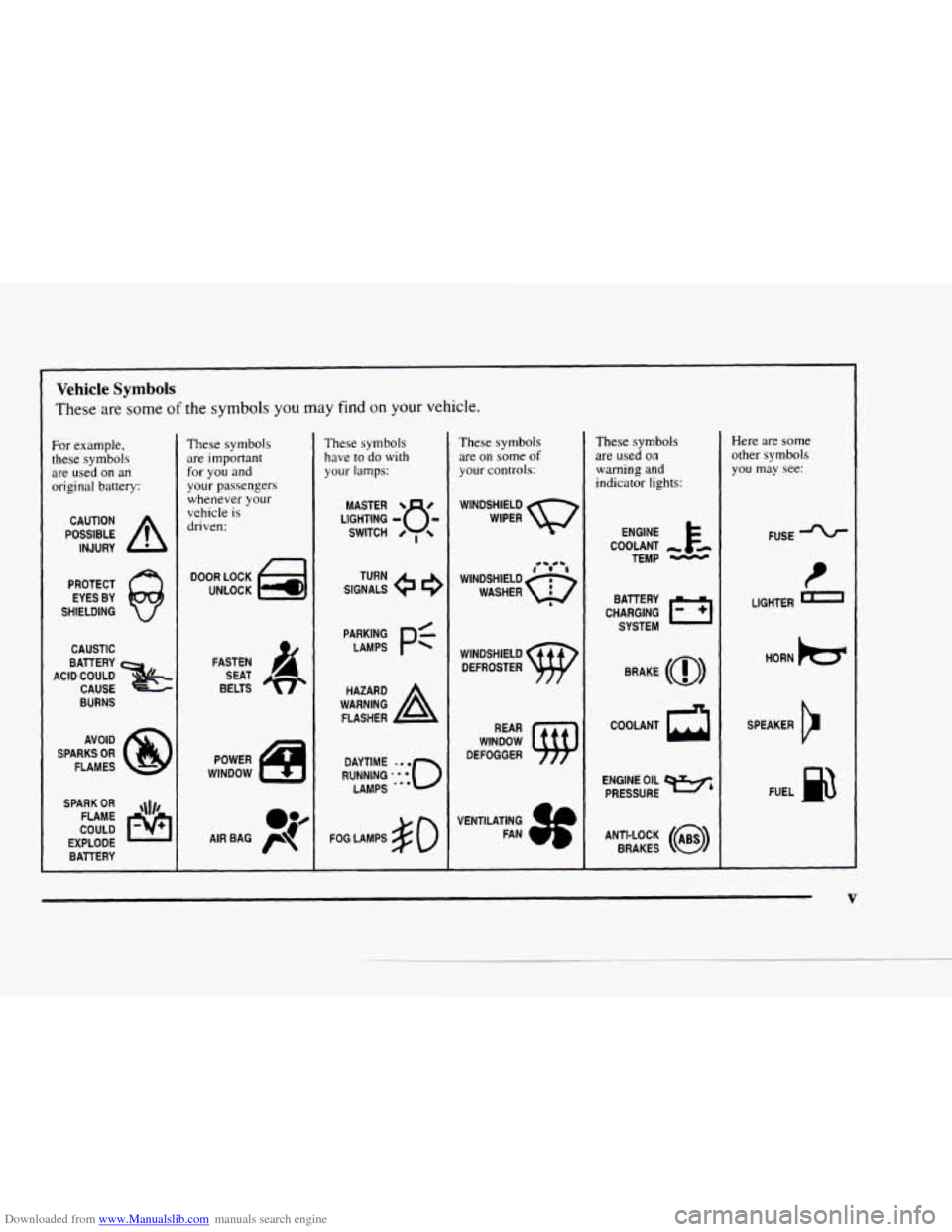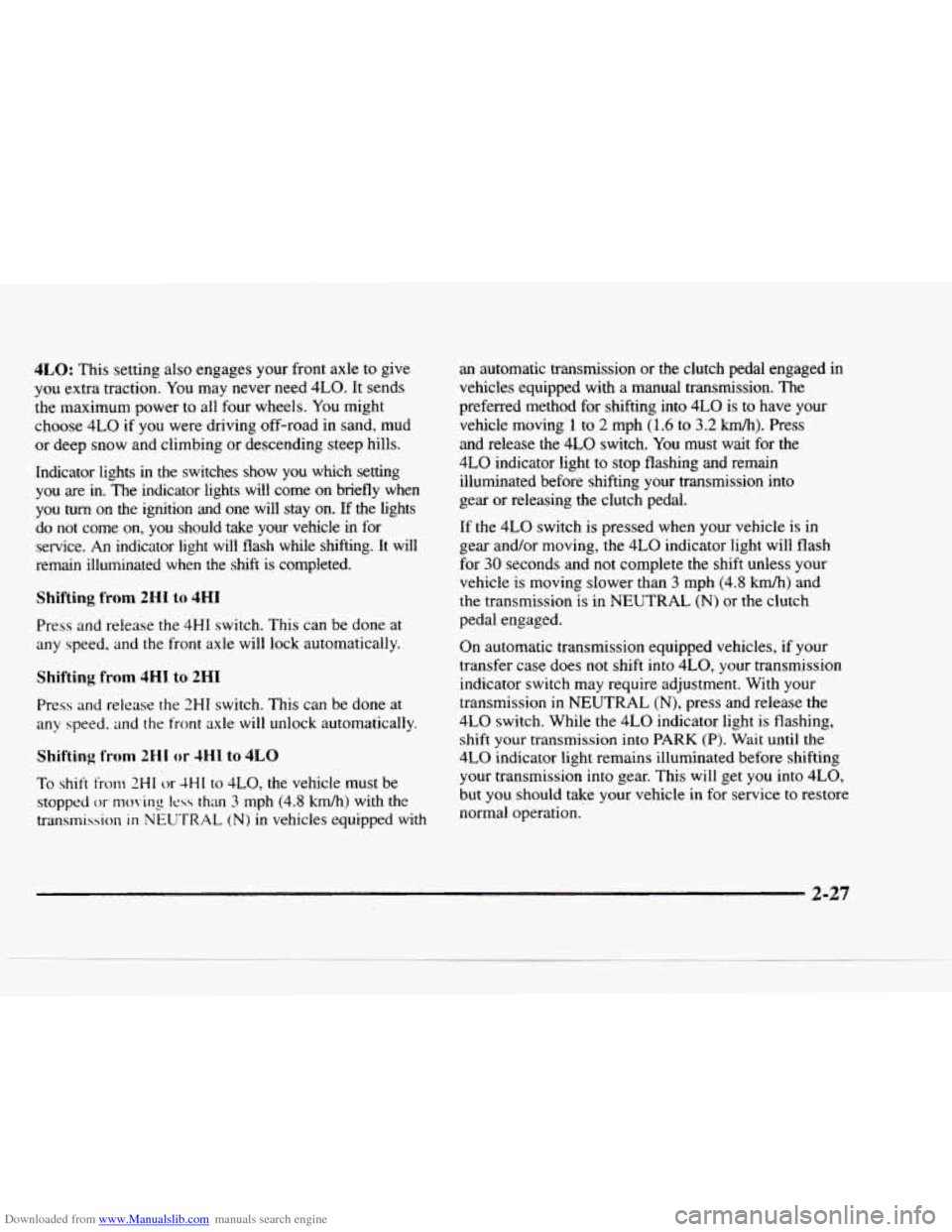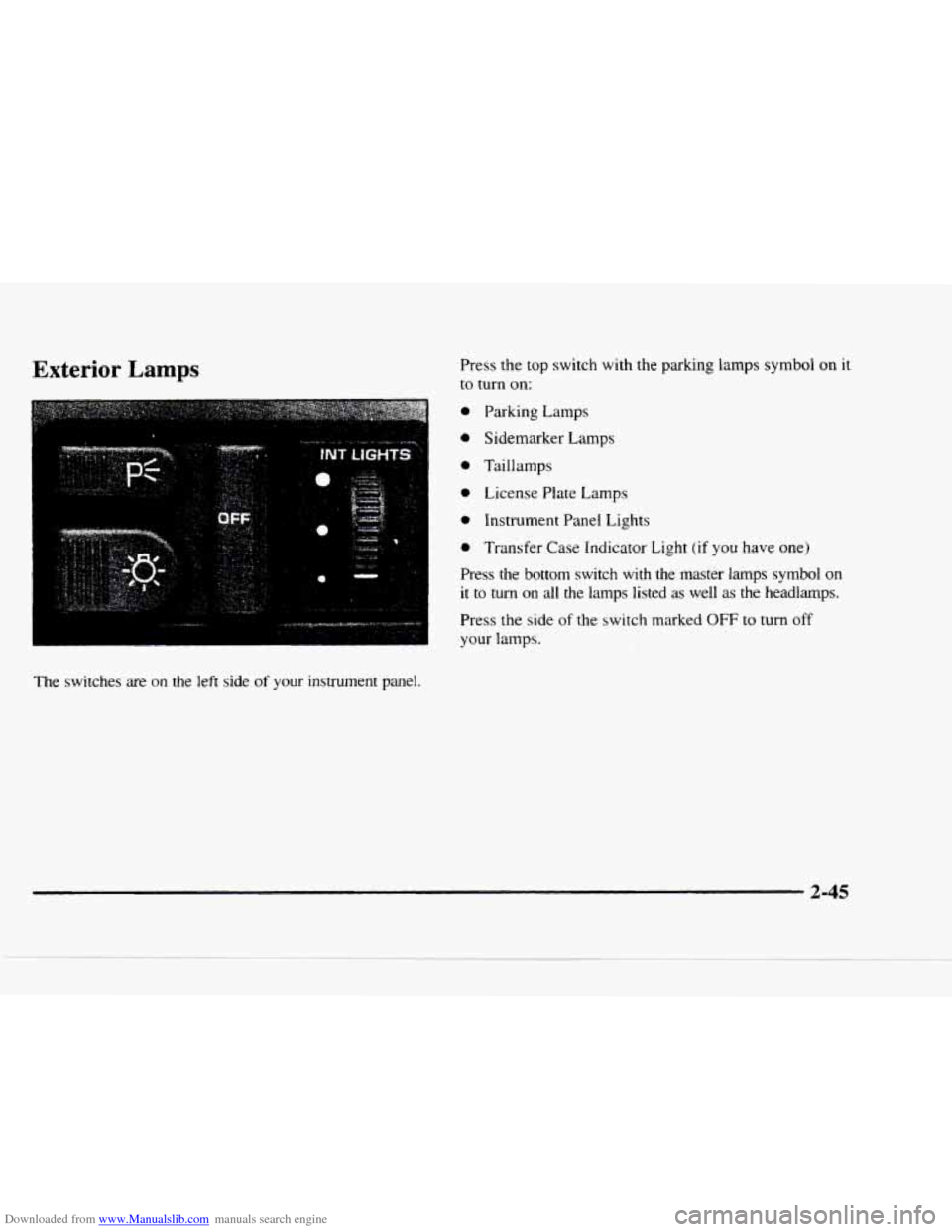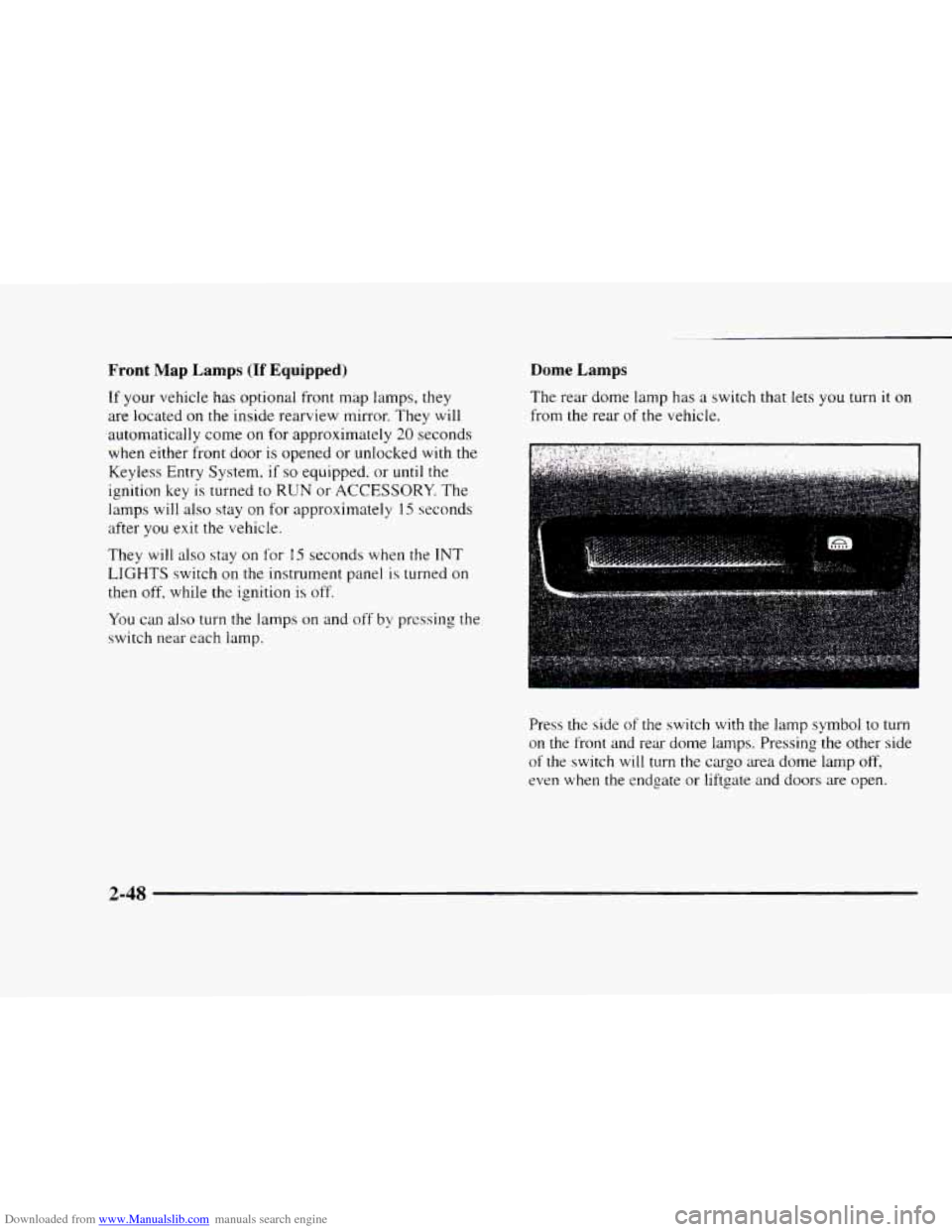1997 CHEVROLET BLAZER lights
[x] Cancel search: lightsPage 6 of 402

Downloaded from www.Manualslib.com manuals search engine Vehicle Symbols
These are some of the symbols you may find on your vehicle.
For example,
these symbols
are used on an
original battery:
POSSIBLE A
CAUTION
INJURY
PROTECT EYES BY
SHIELDING
CAUSTIC
ACID COULD
x
BATTERY CAUSE
BURNS
AVOID
SPARKS
OR
FLAMES
SPARK
OR ,\I/,
COULD FLAME
EXPLODE BATTERY
These symbols
are important
for you
and
your passengers
whenever your
vehicle
is
driven:
DOOR LOCK
UNLOCK
These symbols have
to do with
your lamps:
FASTEN
SEAT
BELTS
POWER
WINDOW
't -I
SIGNALS TURN
A
FLASHER
FOG LAMPS
$0
These symbols
are
on some of
your controls:
WINDSHIELD
WIPER
WINDSHIELD DEFROSTER
WINDOW
DEFOGGER
VENTILATING FAN
1 b
-J
These symbols
are used on
warning and
indicator lights:
COOLANT
TEMP
-
CHARGING EATERY
SYSTEM
BRAKE
(a)
ENGINE OIL e,
PRESSURE
ANTI-LOCK
(@)
BRAKES
Here are some
other symbols
you may see:
FUSE *
I
LIGHTER
HORN
)a(
SPEAKER
b
FUEL la
V
Page 58 of 402

Downloaded from www.Manualslib.com manuals search engine Section 2 Features and Controls
Here you can learn about the many standard and optional features on your vehicle, and information on starting,
shifting and braking.
Also explained are the instrument panel and the warning systems that tell you if everything is
working properly -- and what to do if you have a problem.
2-2
2-6
2-9
2- 12
2-13
2-
13
2- 15
2-
17
2-18
2-2 1
2-23
2-23
2-23
2-29
2-30
2-33 Keys
Keyless Entry
System
(If Equipped)
Endgatekiftgate
Theft
New Vehicle “Break-In”
Ignition Positions
Starting Your Engine
Engine Coolant Heater (Option)
Automatic Transmission Operation
Manual Transmission
Locking Rear Axle
All-Wheel Drive (If Equipped)
Four-wheel Drive (If Equipped)
Parking Brake
Shifting Into
PARK (P) (Automatic
Transmission Models Only)
Shifting Out
of PARK (P)
(Automatic Transmission) 2-33
2-34
2-34
2-35
2-36
2-38
2-45
2-49
2-63
2-63
2- 64
2-67
2-72 Parking
Your Vehicle (Manual Transmission
Models Only) Parking Over Things That Burn
Engine Exhaust
Running Your Engine While You’re Parked
(Automatic Transmission)
Windows
Turn SignaVMultifunction Lever Exterior Lamps
Mirrors
Accessory Power Outlets (If Equipped)
Sunroof
(If Equipped)
Universal Transmitter
(If Equipped)
Instrument Panel
Warning Lights, Gages and Indicators
Page 82 of 402

Downloaded from www.Manualslib.com manuals search engine The front axle portion of the diagram on the indicator
will light up when you shift
into four-wheel drive. A
slight delay between shifting and the pattern’s lighting is
normal. If the pattern does not light up, or if the front
axle lights do not go out after you shift out of
four-wheel drive, have your dealer check your system.
Turn the INT LIGHTS switch located to the right of
your headlamp switch
to dim your transfer case
indicator light when your headlamps or parking lamps
are on. This will also cause your instrument panel lights
to dim.
2HI: This setting is for driving in most street and
highway situations. Your front axle is
not engaged in
two-wheel drive.
4HI: This setting engages your front axle to help
drive
your vehicle. Use 4HI when you need extra
traction, such as on snowy
or icy roads, or in most
off-road situations.
N SET PARK BRAKE: Shift to this neutral setting
only when your vehicle needs to be towed.
4LO: This setting also engages your front axle to give
you extra traction and provides extra gear reduction.
You may never need 4LO. It sends the maximum power
to all four wheels. You might choose 4LO if you were
driving off-road in sand, mud or deep snow and
climbing or descending steep hills.
You can shift from 2HI to 4HI or from 4HI to 2HI while
the vehicle is moving. Do not press the transfer case
shift lever button when shifting from 2HI
to 4HI or
from 4HI to 2HI.
To shift your transfer case into N SET PARK BRAKE:
1. Stop the vehicle and shift your transmission into
NEUTRAL
(N).
2. Set the parking brake. Your vehicle can roll unless
the brakes are applied.
3. Pull the transfer case shift lever into N SET
PARK BRAISE.
2-25
Page 84 of 402

Downloaded from www.Manualslib.com manuals search engine 4LO: This setting also engages your front axle to give
you extra traction. You may never need
4LO. It sends
the maximum power
to all four wheels. You might
choose
4LO if you were driving off-road in sand, mud
or deep snow and climbing or descending steep hills.
Indicator lights
in the switches show you which setting
you are
in. The indicator lights will come on briefly when
you
turn on the ignition and one will stay on. If the lights
do not come on, you should take your vehicle in for
service. An indicator light
will flash while shifting. It will
remain illuminated when the shift is completed.
Shifting from 2HI to 4HI
Press and release the 4HI switch. This can be done at
any speed, and the front axle will lock automatically.
Shifting from 4HI to 2HI
Press and release the 2HI switch. This can be done at
any speed.
and the front axle will unlock automatically.
Shifting from 2HI or JHI to 4LO
To shift tiom ZHI or -!HI to 4L0, the vehicle must be
stopped or mo\fing less than 3 mph (4.8 kmk) with the
transmission
in NEUTRAL (N) in vehicles equipped with
an automatic transmission or the clutch pedal engaged in
vehicles equipped with a manual transmission.
The
preferred method for shifting into 4LO is to have your
vehicle moving
1 to 2 mph (1.6 to 3.2 km/h). Press
and release the
4LO switch. You must wait for the
4LO indicator light to stop flashing and remain
illuminated before shifting your transmission into
gear or releasing the clutch pedal.
If
the 4LO switch is pressed when your vehicle is in
gear and/or moving, the
4LO indicator light will flash
for
30 seconds and not complete the shift unless your
vehicle is moving slower than 3 mph (4.8
kmk) and
the transmission is in
NEUTRAL (N) or the clutch
pedal engaged.
On automatic transmission equipped vehicles,
if your
transfer case does not shift into 4L0, your transmission
indicator switch may require adjustment. With your
transmission in
NEUTRAL (N), press and release the
4LO switch. While the
4LO indicator light is flashing,
shift
your transmission into PARK (P). Wait until the
4LO indicator light remains illuminated before shifting
your transmission into gear. This will get you into 4L0,
but you should take your vehicle in for service to restore
normal operation.
2-27
Page 102 of 402

Downloaded from www.Manualslib.com manuals search engine Exterior Lamps
.. .- I
: ' aD
.-
*
The switches are on the left side of your instrument panel. Press
the top switch with the parking lamps symbol on it
to turn on:
0 Parking Lamps
0 Sidemarker Lamps
0 Taillamps
0 License Plate Lamps
0 Instrument Panel Lights
0 Transfer Case Indicator Light (if you have one)
Press the bottom switch with the master lamps symbol on
it to turn on all the lamps listed as well as the headlamps.
Press the
side of the switch marked OFF to turn off
your lamps.
2-45
Page 104 of 402

Downloaded from www.Manualslib.com manuals search engine Fog Lamps (If Equipped)
I
..
$0 OFF
FOG LAMPS
Use your fog lamps for better vision in foggy or misty
conditions. Your parking lamps or low-beam headlamps
must
be on for your fog lamps to work.
The
fog lamp switch is on the instrument panel under
the lamps switches. Press the side of the switch with the
fog lamp symbol
to turn the fog lamps on. Press OFF to
turn them off. A light will glow in the switch when the
fog lamps are
on.
Remember, fog lamps alone will not give off as much
light as your headlamps. Never
use your fog lamps in
the dark without turning
on your headlamps.
Fog lamps will go off whenever your high-beam
headlamps come
on. When the high beams go off,
the
fog lamps will come on again.
Interior Lamps
Brightness Control
Turn the switch next to the headlamp switch up to
make your instrument panel and transfer case lights
brighter. Turn the switch all the way up to turn on the
interior lamps.
Front Reading Lamps (If Equipped)
Press the button near each lamp on the overhead console
to turn the reading lamps on and off. The lamps can be
swiveled
to point in the desired direction.
If
you have the miniconsole, press the lens on each
reading lamp to turn it on or off.
2-47
Page 105 of 402

Downloaded from www.Manualslib.com manuals search engine Front Map Lamps (If Equipped)
If your vehicle has optional front map lamps, they
are located
on the inside rearview mirror. They will
automatically come
on for approximately 20 seconds
when either front door is opened or unlocked with the
Keyless Entry System,
if so equipped. or until the
ignition key
is turned to RUN or ACCESSORY. The
lamps
will also stay on for approximately 15 seconds
after you exit the vehicle.
They
will also stay on for I5 seconds when the INT
LIGHTS switch on the instrument panel is turned on
then off, while the ignition is off.
You can also turn the lamps on and off by pressing the
switch near each lamp.
Dome Lamps
The rear dome lamp has a switch that lets you turn it on
from the rear of the vehicle.
Press the side
of the switch with the lamp symbol to turn
on the front and rear dome lamps. Pressing the other side
of the switch will turn the cargo area dome lamp off,
even when the endgate or liftgate and doors are open.
2-48
Page 129 of 402

Downloaded from www.Manualslib.com manuals search engine Warning Lights, Gages and Indicators
This part describes the warning lights and gages that
may be on
your vehicle. The pictures will help you
locate them.
Warning lights and gages can signal that something is
wrong before it becomes serious enough to cause an
expensive repair or replacement. Paying attention to
your warning lights and gages could also save you
or
others from injury.
Warning lights come on when there may be
or is a
problem with one of
your vehicle's functions. As you
will see in the details on the next few pages. some
warning lights come on briefly when
you start the
engine just
to let you know they're workinz. If you are
familiar with this section, you
should not be alarmed
when this happens.
Gages can indicate when there may be or is a problem
with one of your vehicle's functions. Often gages and
warning lights
work together to let you know when
there's a problem
with your vehicle. When
one
of the warning lights comes on and stays on
when you are driving, or when one
of the gages shows
there may be a problem, check the section that tells
you
what to do about it. Please follow this manual's advice.
Waiting
to do repairs can be costly -- and even
dangerous.
So please get to know your warning lights
and gages. They're
a big help.
Safety Belt Reminder Light
When the key is turned to RUN or START. a tone will
come on for about eight seconds
to remind people to
fasten their safety belts, unless the driver's safety belt is
already buckled.
The safety belt
light will
also come on and stay on
for about
20 seconds.
then
it will flash for about
55 seconds. If the driver's
belt is already buckled,
neither the tone nor the
light
will come on.
2-72